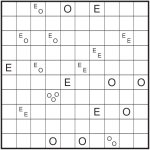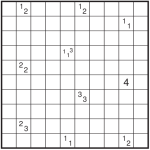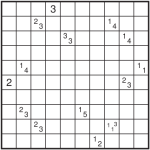In addition to my usual puzzle related activities, I have been managing Team India’s visa application submissions. This has been quite a tough process. As part of the process, I have to stand in queue outside the office for 4 and a half hours, and then sit inside for about an hour more. The puzzles below were part of 9 I wrote when sitting in the office. I was obviously exhausted, and this was more of a “oh, I found a pen and paper, lemme just have a little fun to pass the time” kind of activity. Also, with a pen, I couldn’t erase stuff which makes construction infinitely harder, at least for me. So out of the 9, only 2 ended up working when I reproduced them on the computer. 2 others had easy fixes. The other 5 will have to be discarded as I can’t see what I can do to make them work. This hopefully makes up for my inactivity on this as well as next Thursday. Other than the league post on Tuesday, my next post will be a week after this.
Of the 4 puzzles that made the cut, 3 are Tapa related. This is fitting, as the TVC and CTC are nearing their end. I feel fairly certain of a top 10 finish in CTC, and hopefully somewhere thereabouts in TVC too. Generally happy with how I’ve done this year. The 3 puzzles below have a nice mix of a Classic Tapa, a variant that appeared this year, and a variant from the past. The 4th puzzle is a Shakashaka, which is nothing special.
In other news, the “Around the world in 80 Puzzles” Instruction booklet is out! As announced on this blog before, one of the 4 sets is written by me. I’d like to thank Amit Sowani, for test solving each puzzle and providing some good inputs along the way. I thank Ravi Kumar too, for coming up with the name Indian Intrigue which I liked the most out of the possible names. It was a pleasure working with Zoltan Nemeth and the other Hungarian team members too.
Anyway, puzzles!
P444 : Tapa. Rules for Tapa.
Rated : Medium (could be hard).
P445 : Twopa. If both grids are considered together using the following rule, they will each have a unique solution. In each solution, every clue must behave at least a little bit differently. This means, in a multi-digit clue, some of the digits can have the same behavior, but not all.
Rated : Medium.
P446 : Tapa Trimino. Follow regular Tapa rules (above). Additionally, the wall should only be made up of “L” shaped triminoes without overlapping.
Rated : Hard.
P447 : Shakashaka. Rules for Shakashaka.
Rated : Easy.

P444


















